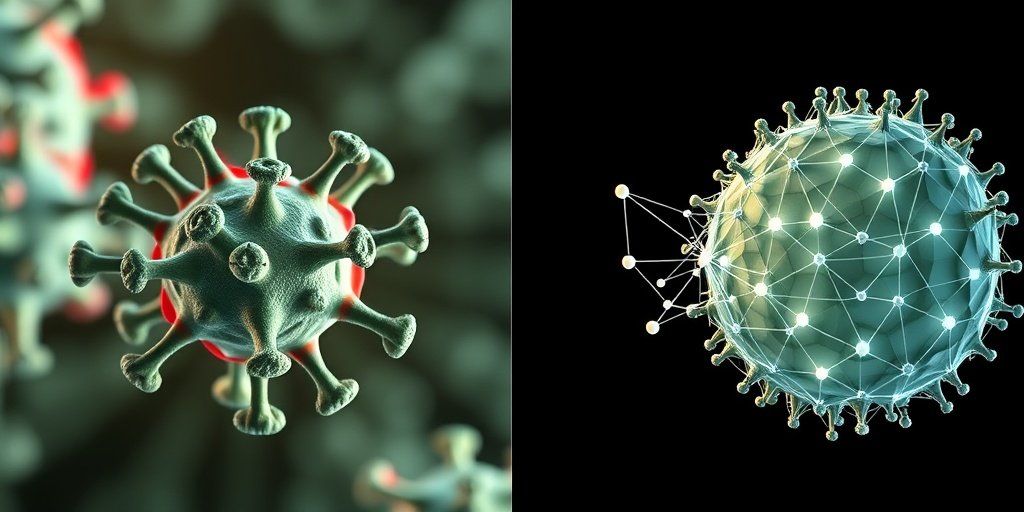⚡ Quick Summary
This study presents a novel approach to analyzing the interactions between the SARS-CoV-2 spike protein and antibodies using a Siamese Neural Network. The model achieved an impressive 90% accuracy in predicting stable and unstable protein complexes, paving the way for advancements in therapeutic antibody and vaccine design.
🔍 Key Details
- 📊 Dataset: Image-based representations of antigens and antibodies interfaces
- 🧩 Features used: Depth maps and geometric descriptors
- ⚙️ Technology: Siamese Neural Network
- 🏆 Performance: Achieved 90% accuracy in interaction predictions
🔑 Key Takeaways
- 🔬 Molecular interactions between antigens and antibodies are crucial for understanding immune responses.
- 🤖 Deep learning models, particularly Siamese Neural Networks, are transforming biomedical research.
- 📈 The model integrates depth maps with geometric descriptors to enhance prediction accuracy.
- 🌐 This approach specifically targets antibodies against the SARS-CoV-2 spike protein.
- 🔍 The network distinguishes between stable and unstable protein complexes effectively.
- 🏆 Extensive testing confirmed the robustness of the model with high accuracy rates.
- 💡 Potential applications include the design of novel antibodies and vaccines.

📚 Background
Understanding the interactions between antigens and antibodies is essential for developing effective therapies against various diseases, including viral infections like COVID-19. Traditional methods of analyzing these interactions can be time-consuming and less precise. The integration of artificial intelligence and deep learning offers a promising avenue for enhancing our understanding of these complex molecular interactions.
🗒️ Study
The study utilized a Siamese Neural Network to analyze the interactions between the SARS-CoV-2 spike protein and its targeting antibodies. By combining depth maps with geometric descriptors, the researchers aimed to capture the geometrical shape complementarity that is critical for distinguishing between stable and unstable protein complexes. The model was trained on a dataset enriched with both binders and non-binders of the spike protein receptor-binding domain.
📈 Results
The Siamese Neural Network demonstrated remarkable performance, achieving an accuracy of 90% in predicting the stability of protein interactions. The model’s ability to compare feature vectors representing molecular surfaces allowed it to effectively differentiate between stable and unstable complexes, showcasing the potential of this approach in biomedical research.
🌍 Impact and Implications
This innovative integration of artificial intelligence with molecular analysis could significantly impact the design of therapeutic antibodies and vaccines. By providing a more accurate understanding of antibody-antigen interactions, researchers can develop more effective treatments for diseases, including COVID-19. The implications of this study extend beyond SARS-CoV-2, potentially benefiting various fields within immunology and therapeutic development.
🔮 Conclusion
The study highlights the transformative potential of deep learning in analyzing molecular interactions. By leveraging advanced technologies like the Siamese Neural Network, researchers can enhance the design of antibodies and vaccines, leading to improved therapeutic outcomes. As we continue to explore the intersection of AI and biomedical research, the future looks promising for innovative solutions in healthcare.
💬 Your comments
What are your thoughts on the use of AI in understanding antibody-antigen interactions? We invite you to share your insights and engage in a discussion! 💬 Leave your comments below or connect with us on social media:
Delineating SARS-CoV-2 spike protein and antibodies interaction interfaces via siamese neural networks: A geometric and image-based analysis.
Abstract
The analysis of molecular interactions between antigens and antibodies is crucial for understanding the immunological mechanisms underlying the immune response and for developing effective therapies against various diseases. In this context, the ability to distinguish between protein interfaces that form stable and unstable complexes is a key step in the design of therapeutic antibodies and vaccines. In recent years, deep learning models have provided advanced tools for biomedical research. This work introduces a novel approach to analyzing antibody-antigen interactions, and in particular SARS-CoV-2 spike protein-targeting antibodies, using a Siamese Neural Network specifically designed to integrate depth maps with geometric descriptors of molecular surfaces. By combining these representations, the model captures geometrical shape complementarity to differentiate between stable and unstable protein complexes. The network was trained using image-based representations of antigens and antibodies interfaces enriched with geometric descriptors, using data that include binders and non-binders of the SARS-CoV-2 spike protein receptor-binding domain. The deep learning network operates by comparing feature vectors representing these molecular surfaces; pairs with closer vectors in feature space are associated with stable interactions, while those with more distant vectors suggest instability. Extensive testing with different configurations achieved an accuracy of 90%, demonstrating the robustness of this approach to predict interactions. This innovative integration of artificial intelligence, depth maps and geometric descriptors offers promising applications for designing novel antibodies and vaccines.
Author: [‘Loreti G’, ‘Vottero P’, ‘Olivetti EC’, ‘Vezzetti E’, ‘Tuszynski J’, ‘Marcolin F’, ‘Aminpour M’]
Journal: PLoS One
Citation: Loreti G, et al. Delineating SARS-CoV-2 spike protein and antibodies interaction interfaces via siamese neural networks: A geometric and image-based analysis. Delineating SARS-CoV-2 spike protein and antibodies interaction interfaces via siamese neural networks: A geometric and image-based analysis. 2025; 20:e0335270. doi: 10.1371/journal.pone.0335270